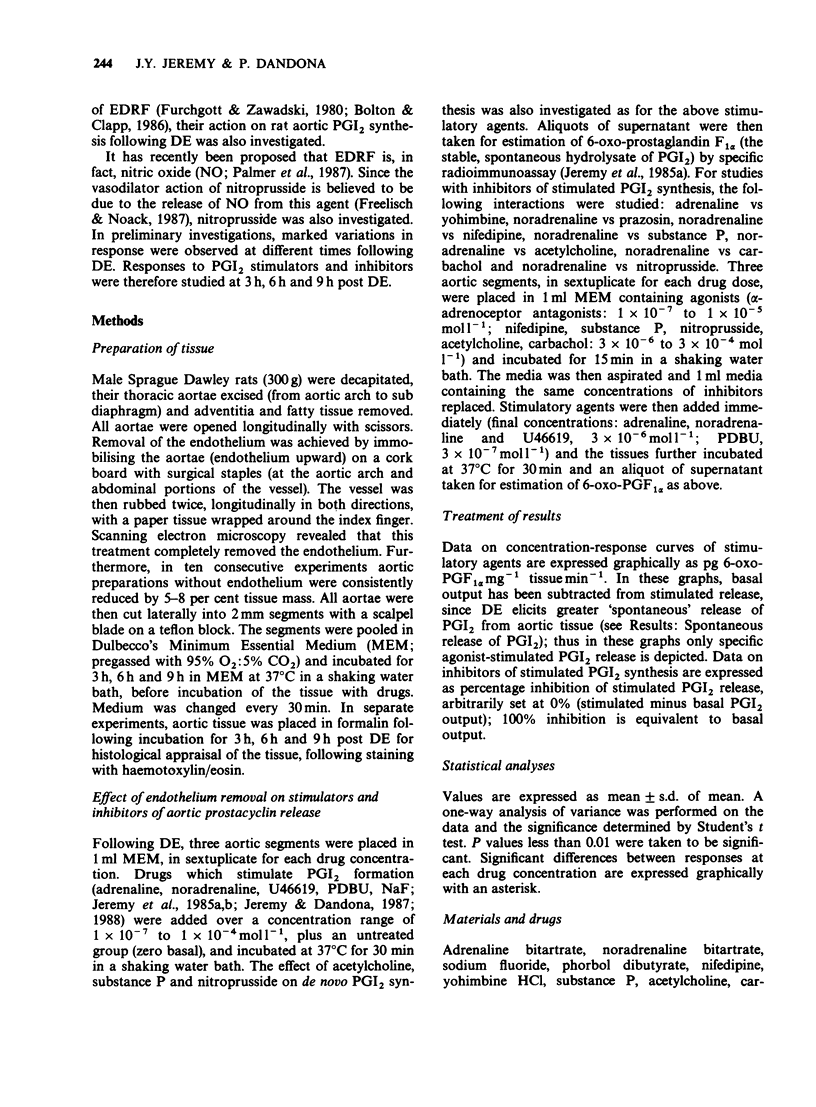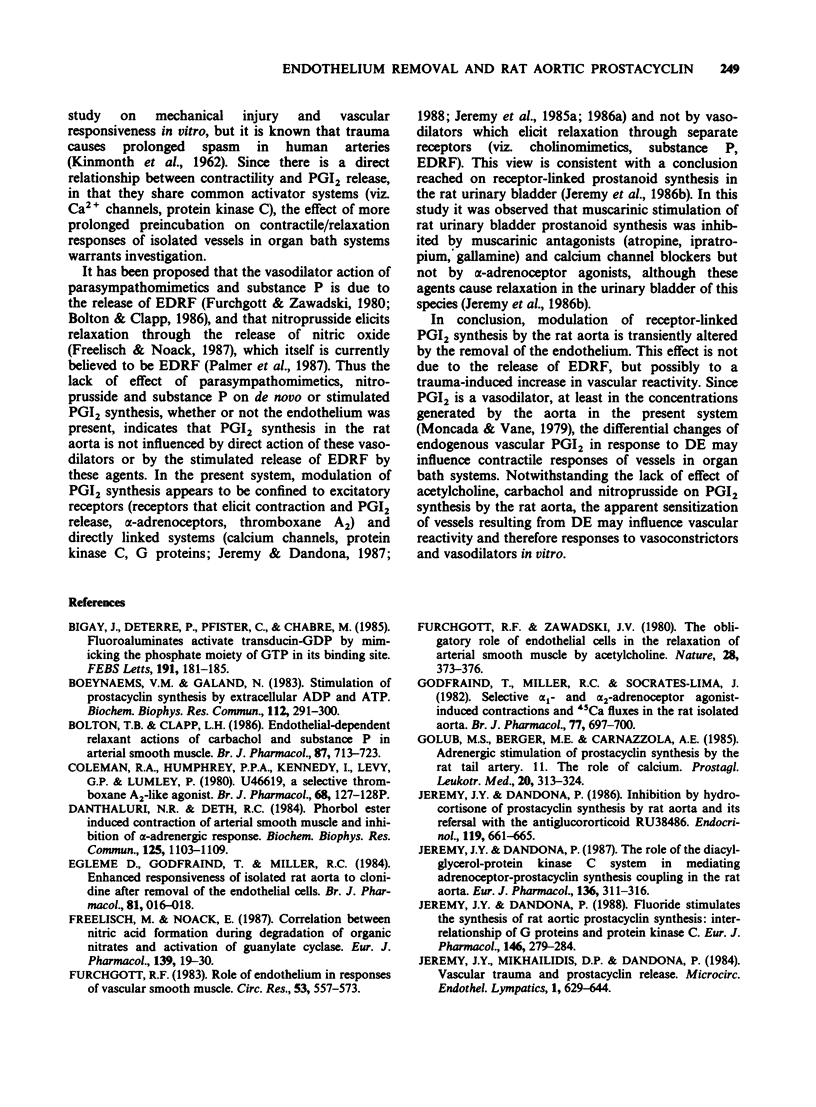Abstract
1. Removal of the endothelium (DE) enhanced the in vitro release of prostacyclin (PGI2) by rat aortae in response to adrenaline (Ad), noradrenaline (NA), thromboxane A2 analogue U46619, phorbol dibutyrate (PDBU) and sodium fluoride (NaF) when assessed at 3 h post DE. At 6 h post DE, there were no differences between the dose-response curves obtained from aortic rings with or without endothelium. 2. At 3 h post DE the antagonism of Ad- and NA-stimulated PGI2 synthesis by yohimbine and prazosin, and NA-stimulated PGI2 synthesis by nifedipine was markedly reduced in aortae without endothelium when compared with controls. These effects were reversed by protracted incubation of aortic tissue post DE (6 h and 9 h). 3. Acetylcholine, carbachol, substance P and nitroprusside were without effect on de novo or NA-stimulated PGI2 synthesis, whether or not the endothelium was present and irrespective of incubation time, post-DE. 4. These results indicate that: (a) PGI2 synthesis linked to excitatory receptors (alpha-adrenoceptors, thromboxane A2) and associated systems (G proteins, protein kinase C) in the smooth muscle component of the rat aorta is not influenced by endothelium-derived relaxing factor (EDRF); (b) the changes of response to stimulators and inhibitors of PGI2 synthesis may be due to an increased reactivity of the vessels caused by the trauma of DE; and (c) vasodilators (parasympathomimetics, substance P and nitroprusside) that do not act directly on excitatory receptors do not influence PGI2 synthesis.
Full text
PDF







Selected References
These references are in PubMed. This may not be the complete list of references from this article.
- Bigay J., Deterre P., Pfister C., Chabre M. Fluoroaluminates activate transducin-GDP by mimicking the gamma-phosphate of GTP in its binding site. FEBS Lett. 1985 Oct 28;191(2):181–185. doi: 10.1016/0014-5793(85)80004-1. [DOI] [PubMed] [Google Scholar]
- Bolton T. B., Clapp L. H. Endothelial-dependent relaxant actions of carbachol and substance P in arterial smooth muscle. Br J Pharmacol. 1986 Apr;87(4):713–723. doi: 10.1111/j.1476-5381.1986.tb14589.x. [DOI] [PMC free article] [PubMed] [Google Scholar]
- Coleman R. A., Humphrey P. P., Kennedy I., Levy G. P., Lumley P. U-46619, a selective thromboxane A2-like agonist? [proceedings]. Br J Pharmacol. 1980 Jan;68(1):127P–128P. [PMC free article] [PubMed] [Google Scholar]
- Danthuluri N. R., Deth R. C. Phorbol ester-induced contraction of arterial smooth muscle and inhibition of alpha-adrenergic response. Biochem Biophys Res Commun. 1984 Dec 28;125(3):1103–1109. doi: 10.1016/0006-291x(84)91397-4. [DOI] [PubMed] [Google Scholar]
- Feelisch M., Noack E. A. Correlation between nitric oxide formation during degradation of organic nitrates and activation of guanylate cyclase. Eur J Pharmacol. 1987 Jul 2;139(1):19–30. doi: 10.1016/0014-2999(87)90493-6. [DOI] [PubMed] [Google Scholar]
- Furchgott R. F. Role of endothelium in responses of vascular smooth muscle. Circ Res. 1983 Nov;53(5):557–573. doi: 10.1161/01.res.53.5.557. [DOI] [PubMed] [Google Scholar]
- Furchgott R. F., Zawadzki J. V. The obligatory role of endothelial cells in the relaxation of arterial smooth muscle by acetylcholine. Nature. 1980 Nov 27;288(5789):373–376. doi: 10.1038/288373a0. [DOI] [PubMed] [Google Scholar]
- Golub M. S., Berger M. E., Carnazzola A. E. Adrenergic stimulation of prostacyclin production in the rat tail artery. II. The role of calcium. Prostaglandins Leukot Med. 1985 Dec;20(3):313–324. doi: 10.1016/0262-1746(85)90153-2. [DOI] [PubMed] [Google Scholar]
- Håkanson R., Hörig J., Leander S. The mechanism of action of a substance P antagonist (D-Pro2, D-Trp7,9)-SP. Br J Pharmacol. 1982 Dec;77(4):697–700. doi: 10.1111/j.1476-5381.1982.tb09348.x. [DOI] [PMC free article] [PubMed] [Google Scholar]
- Jeremy J. Y., Dandona P. Fluoride stimulates in vitro vascular prostacyclin synthesis: interrelationship of G proteins and protein kinase C. Eur J Pharmacol. 1988 Feb 9;146(2-3):279–284. doi: 10.1016/0014-2999(88)90303-2. [DOI] [PubMed] [Google Scholar]
- Jeremy J. Y., Dandona P. Inhibition by hydrocortisone of prostacyclin synthesis by rat aorta and its reversal with RU486. Endocrinology. 1986 Aug;119(2):661–665. doi: 10.1210/endo-119-2-661. [DOI] [PubMed] [Google Scholar]
- Jeremy J. Y., Dandona P. The role of the diacylglycerol-protein kinase C system in mediating adrenoceptor-prostacyclin synthesis coupling in the rat aorta. Eur J Pharmacol. 1987 Apr 29;136(3):311–316. doi: 10.1016/0014-2999(87)90303-7. [DOI] [PubMed] [Google Scholar]
- Jeremy J. Y., Mikhailidis D. P., Dandona P. Prostanoid synthesis by the rat urinary bladder: evidence for stimulation through muscarine receptor-linked calcium channels. Naunyn Schmiedebergs Arch Pharmacol. 1986 Dec;334(4):463–467. doi: 10.1007/BF00569387. [DOI] [PubMed] [Google Scholar]
- Jeremy J. Y., Mikhailidis D. P., Dandona P. Prostanoid synthesis by the rat urinary bladder: evidence for stimulation through muscarine receptor-linked calcium channels. Naunyn Schmiedebergs Arch Pharmacol. 1986 Dec;334(4):463–467. doi: 10.1007/BF00569387. [DOI] [PubMed] [Google Scholar]
- Jeremy J. Y., Mikhailidis D. P., Dandona P. Thromboxane A2 analogue (U-46619) stimulates vascular PGI2 synthesis. Eur J Pharmacol. 1985 Jan 2;107(2):259–262. doi: 10.1016/0014-2999(85)90066-4. [DOI] [PubMed] [Google Scholar]
- Jeremy J. Y., Mikhailidis D. P., Dandona P. Vascular trauma and prostacyclin release. Microcirc Endothelium Lymphatics. 1984 Oct;1(5):629–644. [PubMed] [Google Scholar]
- Moncada S., Herman A. G., Higgs E. A., Vane J. R. Differential formation of prostacyclin (PGX or PGI2) by layers of the arterial wall. An explanation for the anti-thrombotic properties of vascular endothelium. Thromb Res. 1977 Sep;11(3):323–344. doi: 10.1016/0049-3848(77)90185-2. [DOI] [PubMed] [Google Scholar]
- Nishizuka Y. The role of protein kinase C in cell surface signal transduction and tumour promotion. Nature. 1984 Apr 19;308(5961):693–698. doi: 10.1038/308693a0. [DOI] [PubMed] [Google Scholar]
- Palmer R. M., Ferrige A. G., Moncada S. Nitric oxide release accounts for the biological activity of endothelium-derived relaxing factor. Nature. 1987 Jun 11;327(6122):524–526. doi: 10.1038/327524a0. [DOI] [PubMed] [Google Scholar]
- Stewart D., Pountney E., Fitchett D. Norepinephrine-stimulated vascular prostacyclin synthesis. Receptor-dependent calcium channels control prostaglandin synthesis. Can J Physiol Pharmacol. 1984 Nov;62(11):1341–1347. doi: 10.1139/y84-225. [DOI] [PubMed] [Google Scholar]
- Van Dam J., Maddox Y. T., Ramwell P. W., Kot P. A. Role of the vascular endothelium in the contractile response to prostacyclin in the isolated rat aorta. J Pharmacol Exp Ther. 1986 Nov;239(2):390–394. [PubMed] [Google Scholar]


